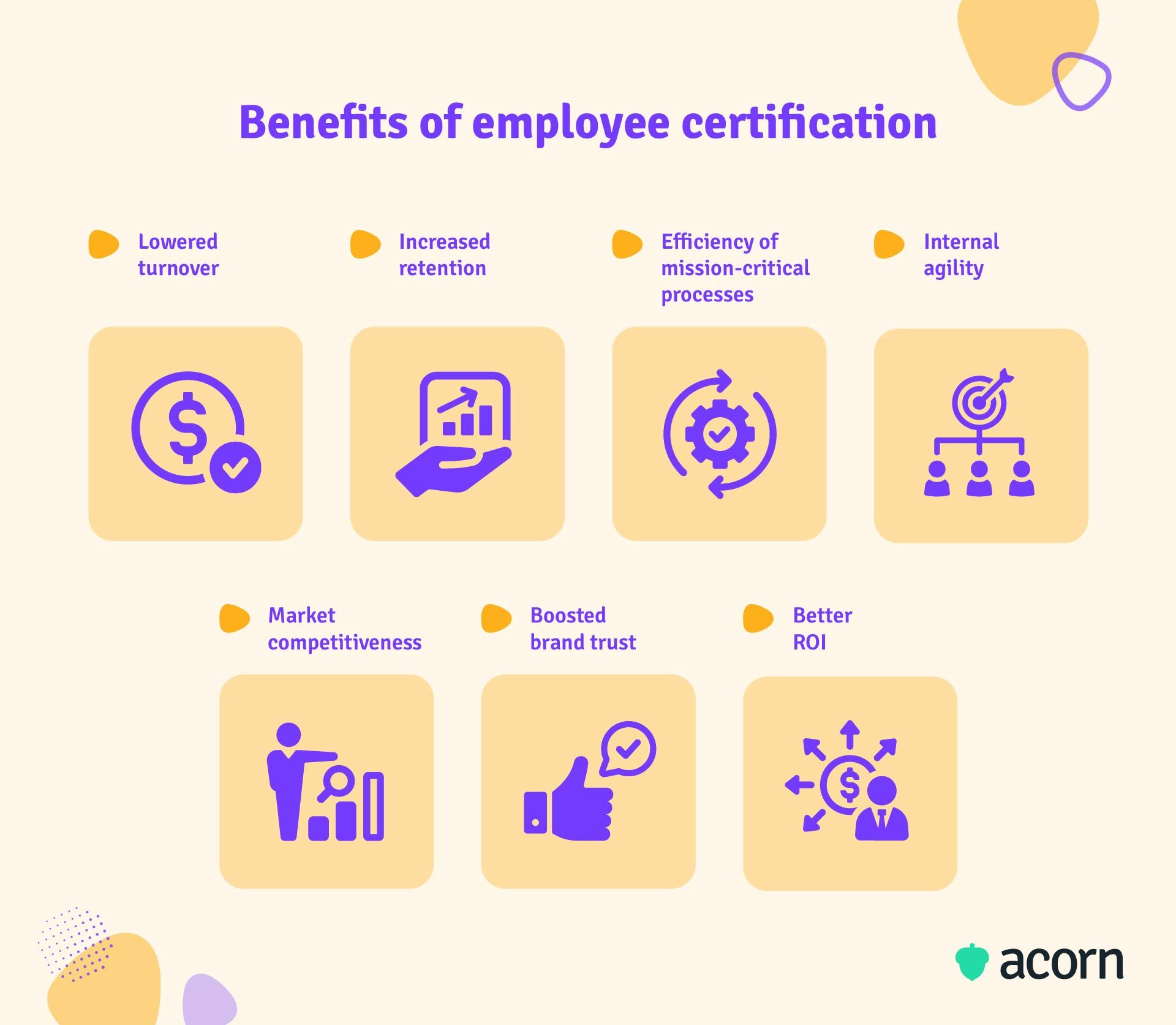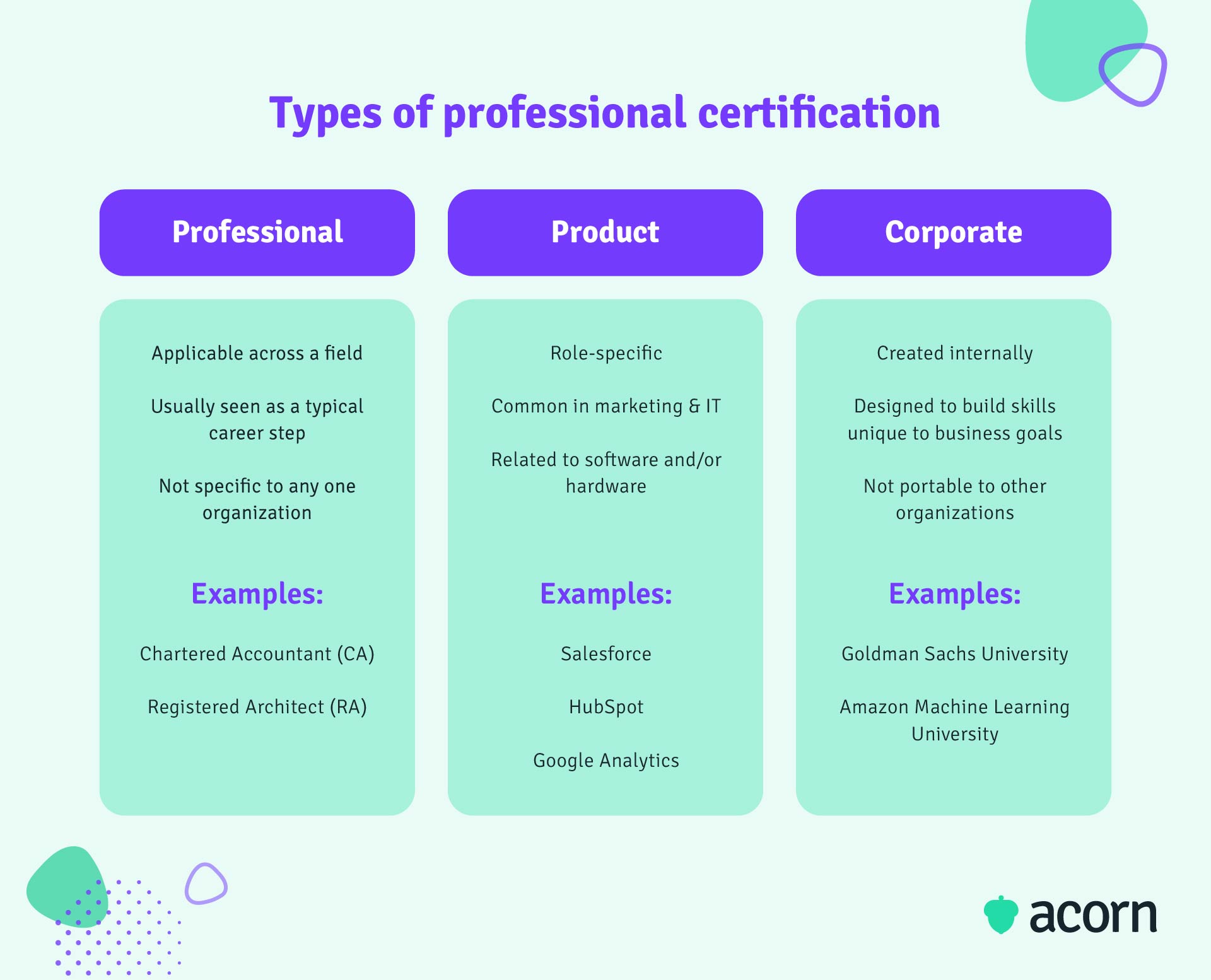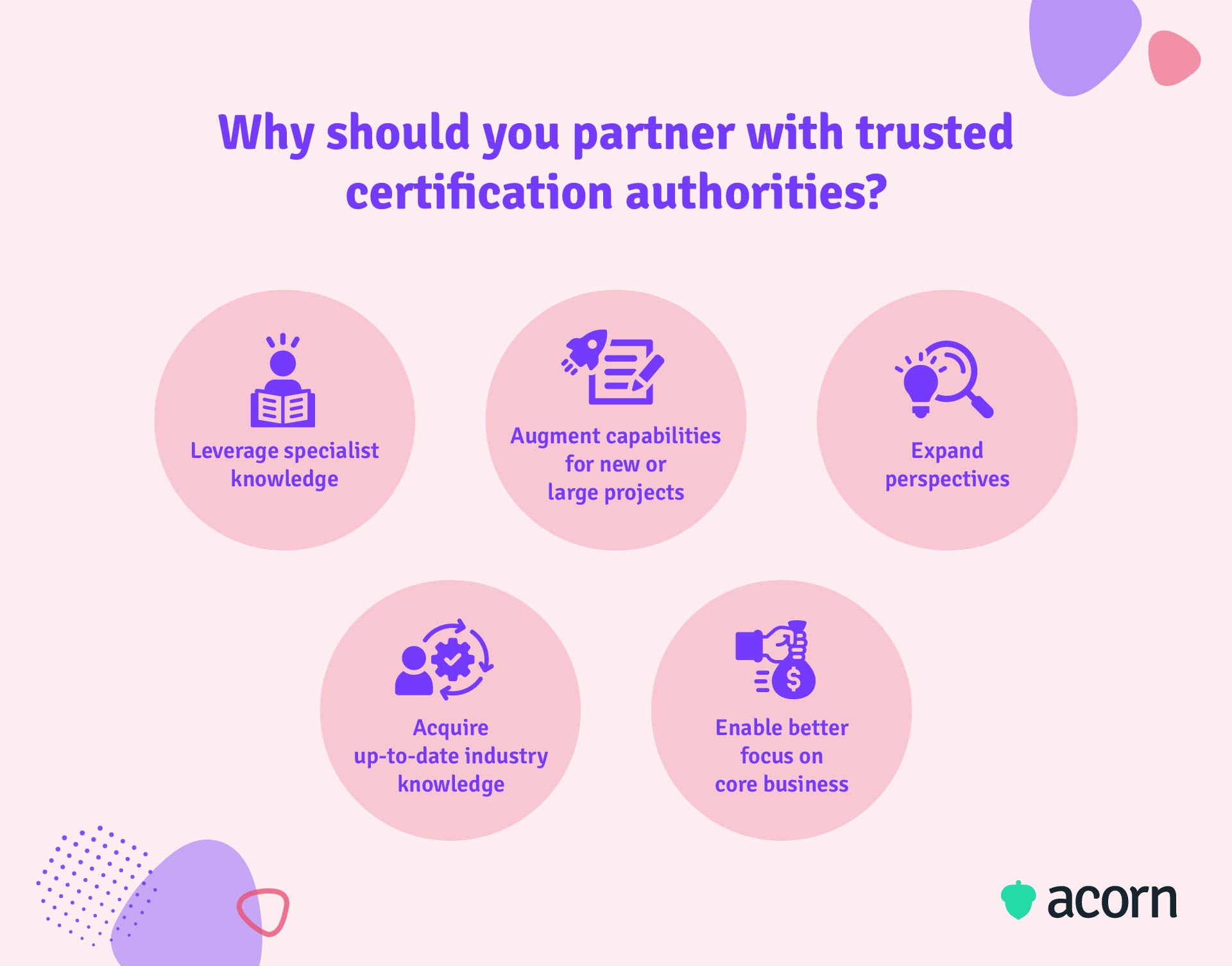How Can Professional Certification Benefit Both Your Business and Employees?
Reading Time:

Lead the pack with the latest in strategic L&D every month— straight to your inbox.
SubscribeCertification is the invisible backbone of your employees’ career progression, and ultimately organizational success. That’s because it’s a facet of continuing education, aka a mutually beneficial business endeavor.
Your employees possess the most up-to-date capabilities, and your business stays competitive with reduced business risk. Sounds good, right? Certification really can be a win-win. But what makes it different from other professional development programs or HR practices?
In this article, we’ll dive deeper into how certification differs from other forms of employee training, the business and employee benefits, and how to effectively incorporate certification in your L&D programs.
What is certification?
Professional certification refers to a focused training program or assessment that develops skills or knowledge needed to perform their job better. The result of a certification course is a credential that formally attests to an individual’s level of achievement in a job-related set of criteria. Third-party institutions are usually responsible for assessment.
Why should you incorporate certification into professional development?
FFirstly, certification is not:
- A replacement for an accredited degree
- A substitute for internal employee training
- An alternative to professional experience.
Rather, professional certification is a chance for employees to build on existing knowledge or skillsets and distinguish themselves from uncertified peers in their field. Whereas tertiary degrees are seen as formal education and necessary precursors to many roles, certification is often viewed as an optional subset of training.
It’s also a chance for you to certify certain knowledge, behaviors, skills, and processes. But we’re getting ahead of ourselves.
Certification as continuing education
Industry-based certification is a rising method of knowledge-building for employees. Some studies have shown that certifications can be used to extend credibility into areas one’s degree did not cover in a quicker timeframe. For this reason, it can be a useful tool to meet market demands in a fickle talent market.
Another way that certification can complement an employee’s standing expertise is by providing more product or role-specific training. There’s an argument that what is learned through university qualifications can be quickly outdated or high-level compared to what an employee actually needs to know in their role—particularly in fields such as IT.
This isn’t to say tertiary education isn’t important (because it is), but let’s consider dentists. They must renew their practitioner registrations and certifications every year to be compliant with the latest regulations and advancements. Would you go to a dentist whose working knowledge is up-to-date as of five years ago? Probably not. (As an aside for you to remember for later, said dentist likely wouldn’t be able to charge as much as their certified peers.)
Therefore, ongoing capability building through certified pathways can be a shrewd way to ensure skills stay relevant amidst environmental changes and that your organization stays competitive.
The key is to curate certifications. Corporate learning has a “more is more” mentality today; most learning solution vendors plug an array of content providers that argue the more content, the more choices for learners.
But you want to ensure learning is always relevant. More content is not the answer; curated content is. This is part of the thinking behind the performance learning management system (PLMS). We pioneered the PLMS to enable organizations to guide learners step-by-step through the capabilities (certified or otherwise) needed in their roles. This is aided by internal and third-party content intelligently curated for each individual based on the capability needs of their role.

Business benefits of offering employee certification
Offering professional certification for employees often means the organization is footing the bill, but it’s an investment you’ll want to make.
Look at it as strategic incremental investments. Every time an employee (or employees) seeks another certification, your company’s value rises. A certified workforce = a certified organization.
You’ll then find the following business benefits stacking up over time:
- Happier, more satisfied employees
- Improved productivity
- Increased availability of skills
- Customer loyalty
- Reduced risk.
A happier workforce
Ignoring employees’ desire to grow and achieve lofty career goals means you’ll probably end up with a disengaged and disloyal workforce. Tapping into the human need for achievement will help develop motivated individuals who want to be challenged.
Achievement motivation describes when people are driven by success or accomplishment. It’s not just a metric for learning and development, but one that helps organizations recognize their high achievers and, in turn, create a continual supply of talent.
Aside from assuring workplace safety and well-being, growth opportunities mean:
- Satisfied employees are less likely to seek greener pastures. Investing in their professional development communicates that they are valuable to and needed at your organization.
- Lowered turnover, which means fewer disruptions to productivity and lowered recruitment and onboarding costs.
- Those employees who are invested in their roles and enthusiastic about their work can inspire their co-workers to act the same. This stamps out resentments, toxicity, and even bad leadership that can spread like wildfire when left unchecked.
- Development creates more confident employees. When they’re sure of their capabilities, having recently reinforced them or built new ones, employees are more productive and less likely to make mistakes. This means leaders don’t need to micromanage their teams, wasting time that should be spent on more strategic tasks.
All this offers your organization two distinct competitive advantages.
- Development is a valuable employee proposition for potential recruits and new hires. For millennials—the largest cohort in the global workforce—the number one factor when considering a company is training. Note that training beats out company culture, workplace flexibility, salary, and work perks, if you were wondering.
- Workplace certification gives your organization actionable insights into highly skilled and motivated employees, allowing you to identify emerging leaders and top talent. This means you have greater internal mobility and can confidently fill vacant roles with existing employees, lowering recruitment costs.
Improved productivity
There’s a widening gap between the companies that take advantage of digitization and those who resist it. Those at the global frontier of efficiency are 3–4 times more productive than their peers. The key lies in combining your human capital with the right technologies—like learning technologies.
Top-performing companies know the importance of developing the right skills in their people. According to IBM, 84% of employees in the best-performing companies say they’re getting the training they need. You don’t even need to be investing huge amounts of time; the same study found that when employees completed 40 hours of relevant training (e.g., project management), any project they worked on was three times more likely to meet objectives.
That could mean with just two hours a week’s worth of relevant study over five months, employees are better equipped to achieve business goals.
So, we’re not just talking about increased productivity but improved productivity. This empowers:
- Learning on the job. This occurs when employees unconsciously learn behaviors, attitudes, and skills by working with others who are more experienced. It’s an invisible kind of workplace learning, but one that underpins your culture.
- Constant capability development. When done as part of strategic workforce planning, professional certification builds new capabilities that underpin productivity. And, again, when you have an abundant pool of capabilities, you’re never short of talent.
- Better team dynamics. Nobody likes working with somebody who doesn’t seem fit for their role. Just one certified professional on a team is one more internal subject matter expert for people to turn to.
Widened talent pool
The skills you have right now will likely be out of date in five years, if they’re not already nearing expiration. Technical skills reach their use-by in just over two. Having the talent you need available all the time is crucial for internal mobility and future-proofing your organization.
So, if gaps frequently occur regardless of your current course of action, you may as well lean into it. Using it as a chance to continually develop relevant and emerging capabilities helps you pivot towards skills that are durable, transferable, and in demand. There’s a rise in “new collar jobs” where employees develop hard and soft skills through non-traditional learning pathways, such as certification courses. It allows you to build the capabilities and roles you need in emerging business areas—artificial intelligence, people and culture, and content marketing amongst them—without waiting for a wave of graduates traditionally trained in these areas.
Why consider new-collar jobs? To avoid unfilled roles, you need to create new pathways for employees as opportunities for your organization to find talent. You could even find candidates that you hadn’t considered before, simply because they weren’t given the chance to undertake specialist study. Internally-built capabilities, whether new, white, or blue collar:
- Drive the growth and evolution of your organization
- Provide a pipeline of leadership talent
- Give you a competitive edge in your market
- Are more cost-effective to nurture.
Boosted credibility
Customer trust and loyalty are crucial to success. It’s your insurance policy. Having certified employees goes a long way toward boosting or maintaining your reputation.
Titles that relate to certifications (e.g., CA or chartered accountant) or qualifications (think MBA) are key here. Remember our dentist analogy? One study found that the more consumers realize what they don’t know about a topic or problem, the more likely they are to seek out a certified professional—and pay more for their services.
Ongoing certification opportunities are then about more than improving the employee experience. Think of it as value add for your target audience. It conveys that an employee (or workforce) with professional credentials has attained a level of expertise that someone without certification has not. As there are many voluntary certifications, it also shows initiative to better oneself and the service they provide.
As an aside, companies with a high level of brand trust are allowed to branch out into new areas. Supermarkets can produce magazines, airlines can sell health insurance, social media sites can plug smart glasses. These new ventures are successful because their audience trusts their brand. Ergo, becoming leaders in your space is directly driven, if not significantly influenced, by who customers perceive to be “certified companies”.
Reduced business risk
You might be tempted to ask, “What if we provide certification for employees and they leave?” After all, it costs as much as 33% of an employee’s annual salary to replace them, another third of which goes towards career development and building institutional knowledge.
It’s better if you look at the situation on its head, and ask what will happen if you don’t train them and they stay.
The loss of institutional knowledge, for one, is nothing compared to compartmentalized business information. Zealous guarding of information and fragmented ownership of processes hinder collaboration and make inevitable handovers incredibly difficult. Information that can’t be readily and easily accessed (unless via the person who keeps it) can affect the turnaround time of projects and business objectives. It can also damage a collaborative culture and can cause toxicity within teams.
Another way to put the cost of employee certification into perspective is to consider the direct correlation between competency, capabilities, and business success. In short: Focusing on performance first, skills second creates more long-lasting change.
A more nuanced explanation follows that professional work certification:
- Gives an organization a database of what employees have what skills and any expiration or refresher dates connected to those. That helps managers and HR leaders understand how competent staff are and ensures knowledge is current.
- Allows you to justify higher costs for services—which could even cover the cost of certification in the long run.
- Helps standardize roles and capabilities. This makes workforce planning easier to manage within your own and industry capability frameworks.

Strategies to implement certification in the workplace
Encouraging employees to seek certification isn’t always the easiest task, considering varying workloads and remote work arrangements.
There are a few steps to incorporate professional certifications into your employee training programs successfully.
- Set ground rules
- Create goals
- Skills application
- Codify capabilities.
Set ground rules
It’ll be a free for all if you don’t determine guidelines for what certifications your organization will recognize. You’ll also want to denote the amount of time you’ll allow employees to study during work hours, as well as any cost-related restrictions.
Tie certification back to the training programs you already have in place. Consider compliance training, leadership development, and department-specific courses. What certifications could complement those? Are there certain designations that you could only offer through a certified course? This isn’t to say you should shut the door on employees pitching courses they believe would be useful. It’s important to encourage this kind of communication with their leaders, and give employees the autonomy to search for career opportunities.
The importance of choosing trustworthy institutions
Not all training institutions are made equal, even if they are industry-recognized. Some may not be recognized in different countries, which could be an issue if you operate on an international scale. Crucial given you’ll want to associate with leading institutions that are universally trusted for the most accurate and high-quality learning content. Look for those who “set the standard” for industries in both brand reputation and practice.

Create goals
Much like learning pathways in learning management systems or PLMSs, you want to give meaning to continuing education. You may align certain certificates against a specific role or progression plan, creating a common language for learners and leaders. Using certification as milestones or goals establishes a pace for employees, giving them the maximum amount of time they can devote to a training program and timeframes for leaders to keep track.
Encourage skills application
Some certifications can be months long. Information that’s learned in week two may be fuzzy compared to the clarity of resources studied in the final month of a program, which is why you want to encourage employees to implement new ideas, skills, and behaviors while still studying. Learning in the flow of work mitigates the forgetting curve, provides a safe environment in which to take risks, and forges adaptable mindsets in real-time.
Codify your own capabilities
If you have the resources, building your certifications in-house is a strategic way to build the specific capabilities your organization needs. A capability academy won’t suit your classic technical or compliance training, but it could be used for niche functional capabilities.
Sales, leadership, and IT are all areas that benefit from a unique and capability-led approach to development, given the niche and strategic roles they play. You can even open your capability academies to partners and customers, providing certificates for specialized knowledge of your services or products. Building your own academy means you can make case studies out of your own people, too, further highlighting and rewarding high performers.
Benefits for employees gaining certifications
So, the skills employees studied so hard for will sadly be outdated quickly. This isn’t all on employees; technologies and specialized processes are updated frequently. Even behavioral skills like project management have a half-life of just over seven years. This is why it’s important to continue learning even after you’ve got a job, and why you employees also experience a few advantages.
Transferable skills
If employees ever want to change roles, they can feel confident in their chances with ongoing certification. When putting yourself forward for a role, particularly one that is a step up in responsibility, it’s a real winner for employers if you have skills that can be applied across industries.
This includes emotional intelligence (big tick for leadership roles) and digital literacy (because it gives businesses a leg up). Internally, it makes you more valuable in mergers or if teams are reshuffled.
Self-confidence
Being confident in one’s knowledge and abilities equates to better performance, a more positive demeanor, and a drive for high-quality work. Without a sense of confidence, you risk becoming a low performer who fears making mistakes, doesn’t take risks, and doesn’t reach their full potential.
Proof of learning ethic
Recruiter Hays found that 77% of employers are more likely to promote a candidate who is regularly upskilling. On the back of that, added certifications ensure your skills are modern and industry-relevant. Proactivity is highly desirable to employers; compared to passive peers, proactive employees perform, contribute, and innovate better.
Increase earning potential
Along the same lines, having documented qualifications gives employees a differentiator. Add value to the Along the same lines, having documented qualifications gives employees a differentiator. Add value to the organization, and you could be rewarded. We know it can be crass to talk money, but just as companies with certified employees can expect to charge more for services or products, certified employees stand to earn more—more than double the standard pay rise for the same role without certification.
Key takeaways
Certification focuses on building the latest industry, role, or product-relevant capabilities. While many people seek it out themselves, it’s a worthwhile endeavor to incorporate into your existing employee training programs.
Continuing education is a big driver of an organization’s credibility, potential revenue, and market standing. For employees, that translates to better career opportunities, self-assurance, increased earning potential, and validation of their abilities.
And for all its benefits, it needn’t be hard to start offering certification to your employees. Aligning courses with current learning objectives ensures you’re not doubling up on information nor paying for irrelevant courses. It’s also key to encourage employees to apply new capabilities in the workplace while they’re still learning, to put new knowledge into practice.e workplace while they’re still learning, to bolster their study and convey confidence in their newfound abilities.